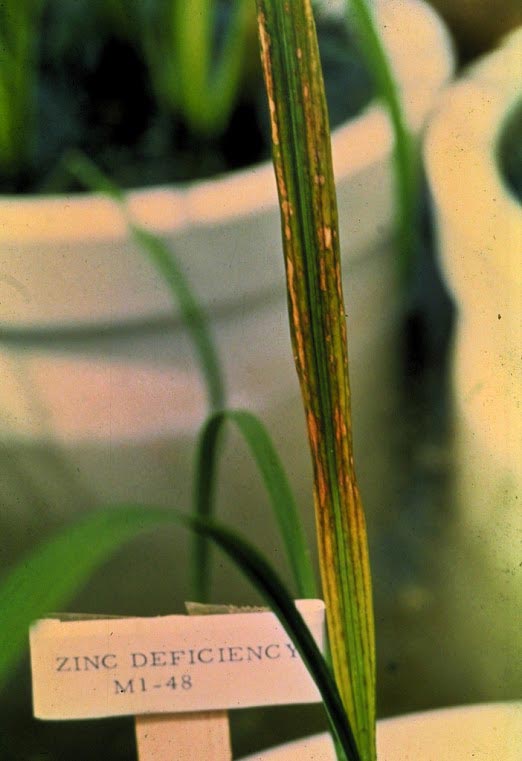Zinc (Zn) deficiency
What it does

Zinc (Zn) deficiency affects several biochemical processes in the rice plant, thus severely affecting plant growth.
Why and where it occurs
Zinc deficiency is associated with Sulfur deficiency.
It can occur in neutral and calcareous soils, intensively cropped soils, paddy soils and very poorly drained soils, sodic and saline soils, peat soils, soils with high available Phosphorus (P) and Silicon (Si) status, sandy soils, highly weathered, acid, and coarse-textured soils, soils derived from serpentine and laterite, and leached, old acid sulfate soils with a small concentration of Potassium (K), Magnesium (Mg), and Calcium (Ca).
Zn deficiency can also be caused by one or more of the following factors:
- small amount of available Zn in the soil.
- planted varieties are susceptible to Zn deficiency (i.e., Zn-inefficient cultivars).
- high pH (close to seven or alkaline under anaerobic conditions). Solubility of Zn decreases by two orders of magnitude for each unit increase in pH. Zn is precipitated as sparingly soluble Zn(OH)2 when pH increases in acid soil following flooding.
- high HCO3- concentration because of reducing conditions in calcareous soils with high organic matter content or because of large concentrations of HCO3- in irrigation water.
- depressed Zn uptake because of an increase in Iron (Fe), Ca, Mg, Copper (Cu), Manganese (Mn), and P after flooding.
- formation of Zn-phosphates following large applications of P fertilizer. High P content in irrigation water (only in areas with polluted water).
- formation of complexes between Zn and organic matter in soils with high pH and high organic matter content or because of large applications of organic manures and crop residues.
- precipitation of Zn as ZnS when pH decreases in alkaline soil following flooding.
- excessive liming.
- wide Mg:Ca ratio (i.e., >1) and adsorption of Zn by CaCO3 and MgCO3. Excess Mg in soils derived from ultrabasic rocks.
Zinc deficiency is the most widespread micronutrient disorder in rice. Its occurrence has increased with the introduction of modern varieties, crop intensification, and increased Zn removal.
How to identify
Symptoms appear between two to four weeks after transplanting. Check the field for the following symptoms:
- dusty brown spots on upper leaves of stunted plants
- uneven plant growth and patches of poorly established hills in the field, but the crop may recover without intervention
- increased spikelet sterility in rice
- chlorotic midribs, particularly near the leaf base of younger leaves
- leaves lose turgor and turn brown as brown blotches and streaks appear on lower leaves, enlarge, and coalesce
- white line sometimes appears along the leaf midrib
- leaf blade size is reduced
Under severe Zn deficiency, tillering decreases and can stop completely and time to crop maturity increases.
Other effects on growth include the following:
- Symptoms may be more pronounced during early growth stages because of Zn immobilization (due to increased bicarbonate concentration in the soil under strongly reducing conditions following flooding). If the deficiency is not severe, plants can recover after 4−6 weeks, but maturity is delayed and yield reduced.
Zinc deficiency has similar symptoms as Iron (Fe) deficiency (also occurs on alkaline soils), Fe toxicity (leaf spots, appearance), grassy stunt virus, and tungro virus.
Compared with Zn deficiency, Fe toxicity occurs on high organic status soils with low pH.
To confirm Zn deficiency, send soil and plant sample to the laboratory for testing.
Why is it important
In Japan, Zn deficiency is the cause of the "Akagare Type II" disorder in rice. Its damage is important throughout the growth cycle of the crop.
How to manage
Preventing Zn deficiency is an intricate part of general crop management. The following are the general measures to prevent Zn deficiencies:
- Grow Zn-efficient varieties.
Contact your local agriculture office for an up-to-date list of available varieties. - Use fertilizers that generate acidity (e.g., replace some urea with ammonium sulfate).
- Apply organic manure before seeding or transplanting or applied to the nursery seedbed a few days before transplanting.
- Allow permanently flooded fields (e.g., where three crops per year are grown) to drain and dry out periodically.
- Monitor irrigation water quality.
Where possible,
- Broadcast ZnSO4 in nursery seedbed
- Dip seedlings or presoak seeds in a 2−4% ZnO suspension (e.g., 20−40 g ZnO L-1 H2O)







